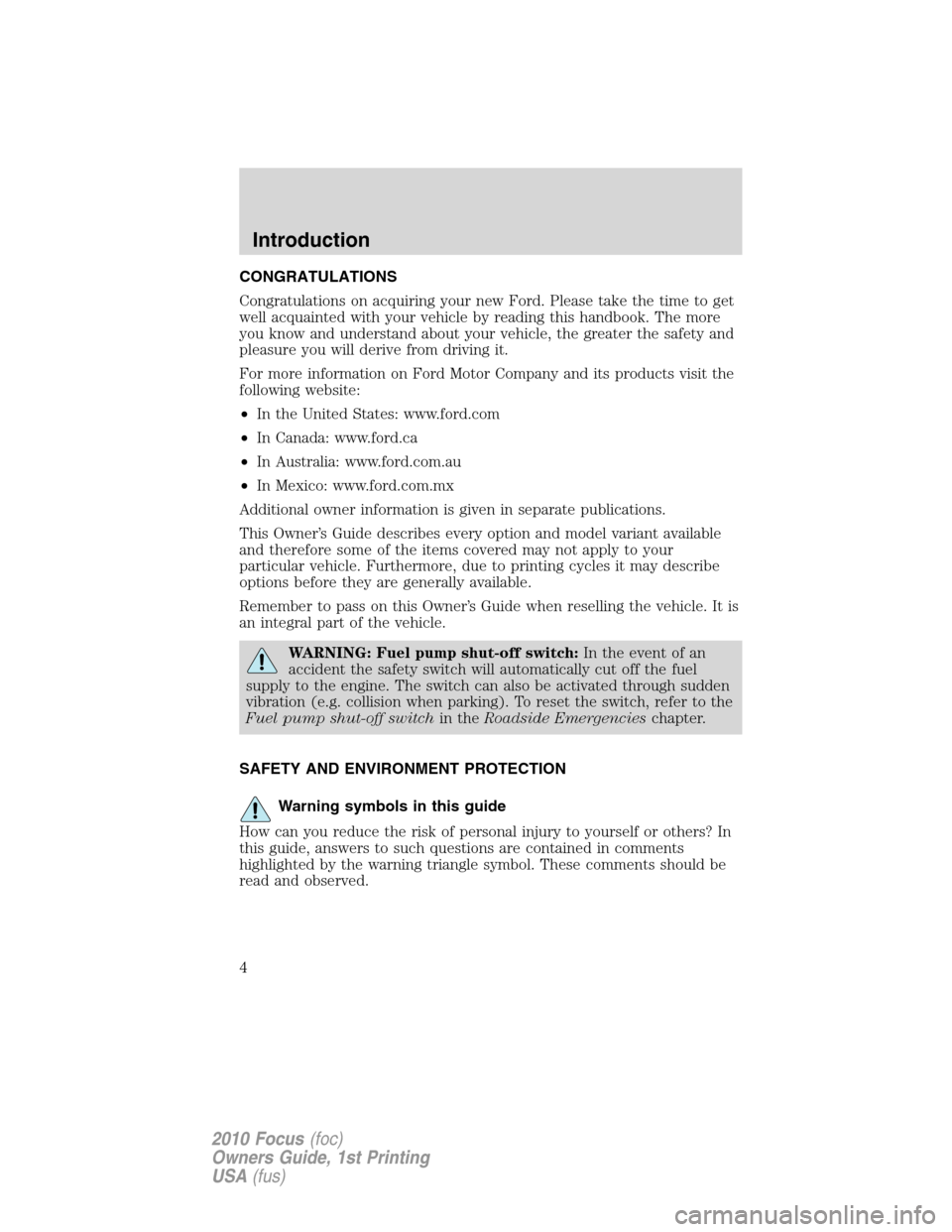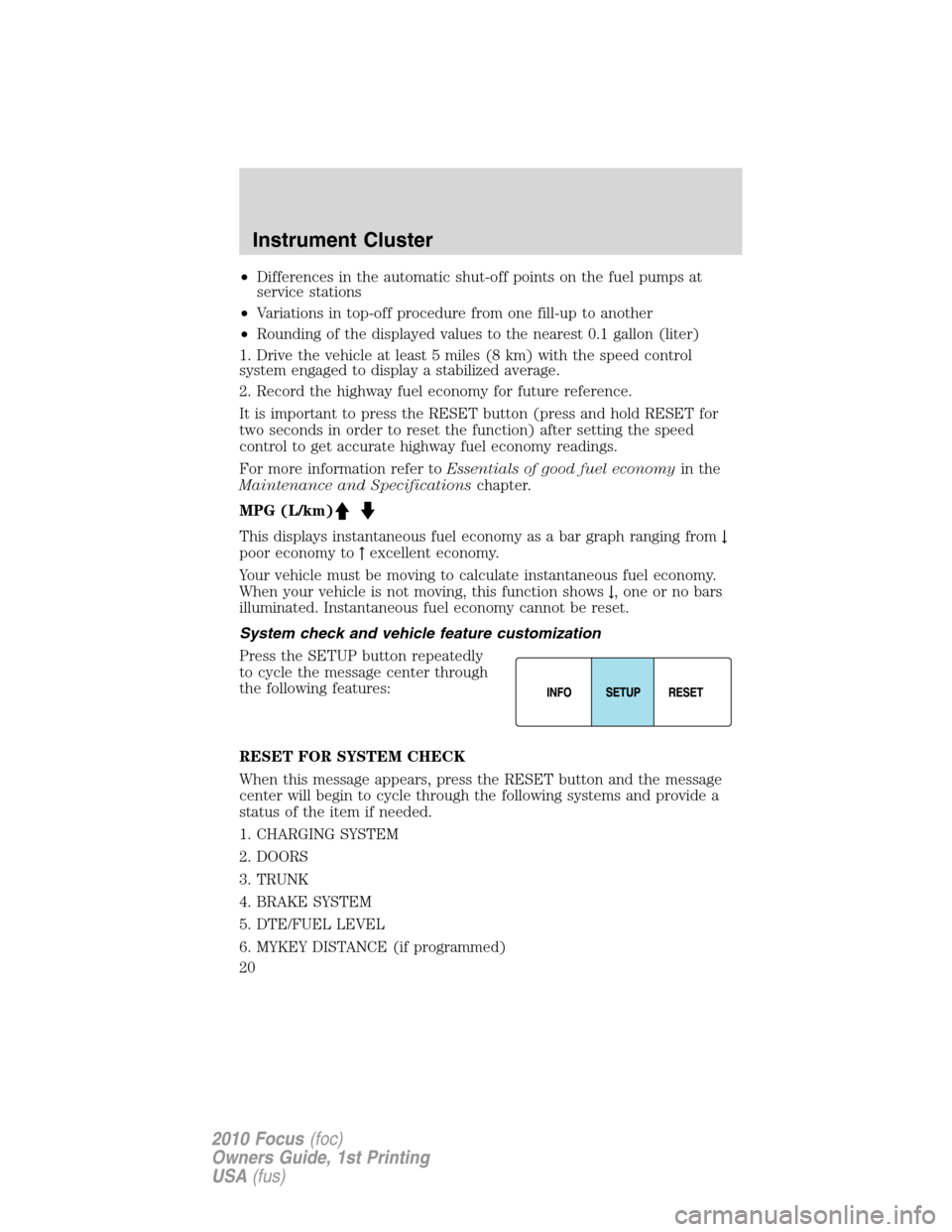Page 2 of 275
Seating and Safety Restraints 88
Seating 88
Safety restraints 96
Airbags 110
Child restraints 125
Tires, Wheels and Loading 144
Tire information 144
Tire inflation 146
Tire Pressure Monitoring System (TPMS) 158
Vehicle loading 163
Trailer towing 169
Recreational towing 169
Driving 171
Starting 171
Brakes 176
AdvanceTrac�179
Transmission operation 184
Roadside Emergencies 190
Getting roadside assistance 190
Hazard flasher control 191
Fuel pump shut-off switch 192
Fuses and relays 192
Changing tires 199
Wheel lug nut torque 204
Jump starting 205
Wrecker towing 211
Customer Assistance 213
Reporting safety defects (U.S. only) 219
Reporting safety defects (Canada only) 219
Cleaning 220
Table of Contents
2
2010 Focus(foc)
Owners Guide, 1st Printing
USA(fus)
Page 4 of 275

CONGRATULATIONS
Congratulations on acquiring your new Ford. Please take the time to get
well acquainted with your vehicle by reading this handbook. The more
you know and understand about your vehicle, the greater the safety and
pleasure you will derive from driving it.
For more information on Ford Motor Company and its products visit the
following website:
•In the United States: www.ford.com
•In Canada: www.ford.ca
•In Australia: www.ford.com.au
•In Mexico: www.ford.com.mx
Additional owner information is given in separate publications.
This Owner’s Guide describes every option and model variant available
and therefore some of the items covered may not apply to your
particular vehicle. Furthermore, due to printing cycles it may describe
options before they are generally available.
Remember to pass on this Owner’s Guide when reselling the vehicle. It is
an integral part of the vehicle.
WARNING: Fuel pump shut-off switch:In the event of an
accident the safety switch will automatically cut off the fuel
supply to the engine. The switch can also be activated through sudden
vibration (e.g. collision when parking). To reset the switch, refer to the
Fuel pump shut-off switchin theRoadside Emergencieschapter.
SAFETY AND ENVIRONMENT PROTECTION
Warning symbols in this guide
How can you reduce the risk of personal injury to yourself or others? In
this guide, answers to such questions are contained in comments
highlighted by the warning triangle symbol. These comments should be
read and observed.
Introduction
4
2010 Focus(foc)
Owners Guide, 1st Printing
USA(fus)
Page 8 of 275

may seek to access the information independently of Ford Motor
Company and Ford of Canada. To the extent that any law
pertaining to Event Data Recording applies to SYNC�or its
features, please note the following: Once 911 Assist (if equipped)
is enabled (set ON), 911 Assist may, through any paired and
connected cell phone, disclose to emergency services that the
vehicle has been in a crash involving the deployment of an airbag
or, in certain vehicles, the activation of the fuel pump shut-off.
Certain versions or updates to 911 Assist may also be capable of
electronically or verbally disclosing to 911 operators the vehicle
location, and/or other details about the vehicle or crash to assist
911 operators to provide the most appropriate emergency
services. If you do not want to disclose this information, do not
activate the feature. See your SYNC�supplement for more
information. Additionally, when you connect to Traffic, Directions
and Information (if equipped, U.S. only), the service uses GPS
technology and advanced vehicle sensors to collect the vehicle’s
current location, travel direction, and speed (“vehicle travel
information”) only to help provide you with the directions, traffic
reports, or business searches you request. If you do not want
Ford or its vendors to receive this information, do not activate
the service. Ford Motor Company and the vendors it uses to
provide you with this information do not store your vehicle travel
information. For more information, see Traffic, Directions and
Information, Terms and Conditions. See your SYNC�supplement
for more information.
CELL PHONE USE
The use of Mobile Communications Equipment has become increasingly
important in the conduct of business and personal affairs. However,
drivers must not compromise their own or others’ safety when using
such equipment. Mobile Communications can enhance personal safety
and security when appropriately used, particularly in emergency
situations. Safety must be paramount when using mobile communications
equipment to avoid negating these benefits.
Mobile Communication Equipment includes, but is not limited to cellular
phones, pagers, portable email devices, in-vehicle communications
systems, telematics devices and portable two-way radios.
Introduction
8
2010 Focus(foc)
Owners Guide, 1st Printing
USA(fus)
Page 10 of 275
These are some of the symbols you may see on your vehicle.
Vehicle Symbol Glossary
Safety Alert
See Owner’s Guide
Fasten Safety BeltAirbag - Front
Airbag - SideChild Seat Lower
Anchor
Child Seat Tether
AnchorBrake System
Anti-Lock Brake SystemParking Brake System
Brake Fluid -
Non-Petroleum BasedParking Aid System
Stability Control SystemSpeed Control
Master Lighting SwitchHazard Warning Flasher
Fog Lamps-FrontFuse Compartment
Fuel Pump ResetWindshield Wash/Wipe
Windshield
Defrost/DemistRear Window
Defrost/Demist
Introduction
10
2010 Focus(foc)
Owners Guide, 1st Printing
USA(fus)
Page 20 of 275

•Differences in the automatic shut-off points on the fuel pumps at
service stations
•Variations in top-off procedure from one fill-up to another
•Rounding of the displayed values to the nearest 0.1 gallon (liter)
1. Drive the vehicle at least 5 miles (8 km) with the speed control
system engaged to display a stabilized average.
2. Record the highway fuel economy for future reference.
It is important to press the RESET button (press and hold RESET for
two seconds in order to reset the function) after setting the speed
control to get accurate highway fuel economy readings.
For more information refer toEssentials of good fuel economyin the
Maintenance and Specificationschapter.
MPG (L/km)
This displays instantaneous fuel economy as a bar graph ranging from↓
poor economy to↑excellent economy.
Your vehicle must be moving to calculate instantaneous fuel economy.
When your vehicle is not moving, this function shows↓, one or no bars
illuminated. Instantaneous fuel economy cannot be reset.
System check and vehicle feature customization
Press the SETUP button repeatedly
to cycle the message center through
the following features:
RESET FOR SYSTEM CHECK
When this message appears, press the RESET button and the message
center will begin to cycle through the following systems and provide a
status of the item if needed.
1. CHARGING SYSTEM
2. DOORS
3. TRUNK
4. BRAKE SYSTEM
5. DTE/FUEL LEVEL
6. MYKEY DISTANCE (if programmed)
Instrument Cluster
20
2010 Focus(foc)
Owners Guide, 1st Printing
USA(fus)
Page 192 of 275

Note:With extended use, the flasher may run down your battery.
FUEL PUMP SHUT-OFF SWITCH
This device stops the electric fuel pump from sending fuel to the engine
when your vehicle has had a substantial jolt.
After an accident, if the engine cranks but does not start, this switch
may have been activated.
This switch is located in the front
passenger’s footwell, behind the kick
panel access cover.
To reset the switch:
1. Turn the ignition off.
2. Check the fuel system for leaks.
3. If no leaks are apparent, reset the
switch by pressing in on the reset
button.
4. Turn the ignition to the on position.
5. Wait a few seconds and return the key to off.
6. Make another check for leaks.
FUSES AND RELAYS
Fuses
If electrical components in the
vehicle are not working, a fuse may
have blown. Blown fuses are
identified by a broken wire within
the fuse. Check the appropriate
fuses before replacing any electrical
components.
Note:Always replace a fuse with one that has the specified amperage
rating. Using a fuse with a higher amperage rating can cause severe wire
damage and could start a fire.
15
Roadside Emergencies
192
2010 Focus(foc)
Owners Guide, 1st Printing
USA(fus)
Page 197 of 275
To remove a fuse, use the fuse puller tool provided on the inside of the
passenger compartment fuse panel cover.
The high-current fuses are coded as follows:
Fuse/Relay
LocationFuse Amp
RatingProtected circuits
1 15A Heated mirror
2 30A Rear defrost
3 20A Power point
4 20A Fuel pump
5 10A Powertrain control module (PCM)
keep alive power, Canister Vent
6 15A Alt sense
7 10A Reverse lamps
8 — Not used
9 40A Anti-lock brake system (ABS)
motor
10 30A Wipers
11 30A Starter
12 40A Blower
13 10A A/C clutch
14 10A PCM relay coil
15 20A Power point
16 20A Cooling fan—low
17 30A Cooling fan—high
Roadside Emergencies
197
2010 Focus(foc)
Owners Guide, 1st Printing
USA(fus)
Page 198 of 275
Fuse/Relay
LocationFuse Amp
RatingProtected circuits
18 20A ABS solenoid
19 — Not used
20 — A/C clutch relay
21A Rear defrost relay
21B — Not used
21C — Blower relay
21D — PCM relay
22 10A Fuel injector
23 — Not used
24 — Not used
25 — Not used
26 15A PCM – emission related
powertrain components
27 — Not used
28 15A PCM
29 15A Ignition
30A — Cooling fan low speed relay
30B — Starter relay
30C — Not used
30D — Cooling fan high speed relay
31A — Reverse lamp relay
31B — Fuel pump relay
31C — Wiper power relay
31D — Not used
31E — Not used
31F — Not used
32 — A/C clutch diode
33 — EEC diode
34 — One touch integrated start (OTIS)
diode
35 10A Run/Start
Roadside Emergencies
198
2010 Focus(foc)
Owners Guide, 1st Printing
USA(fus)